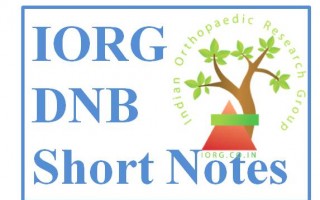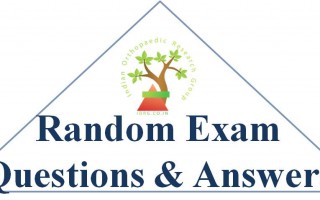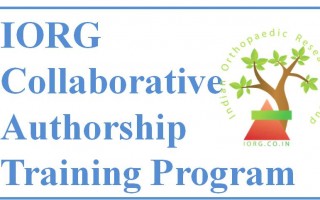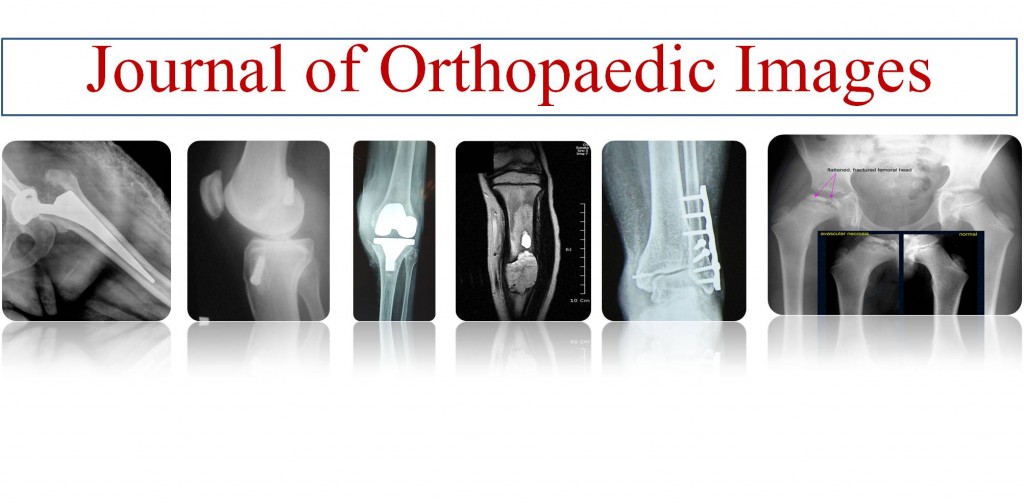A picture speaks more than a thousand words and we as Orthopaedic Surgeons come across a a lot of such images. These images often challenge our knowledge and prejudice and teach us valuable lessons of clinical practice. These do not fit into any level of Evidence but nevertheless they are important form practical point of view. Journal of Orthopaedic Images will provide an online platform for these images.
The Journal of Orthopaedic Images will be an open access, Peer Reviewed, online only Journal which will be published biannually. The article that have finished peer reviewed will be published online as ahead of print to avoid delay in citations, and will be compiled in two annual issues.
Again in lines with Journal of Orthopaedic Case Reports, the journal will have its own ISSN number and will be Indexed in few months after the first Issue.
Soon a website with detailed instruction will be made online, however we are open to Submission now through email to editor.jimage@gmail.com
Scope of the Journal
- Journal of Orthopaedic Images will accept all kinds of images, including but not limited to, Radiographs, MRI, CT Scans, Arthroscopy Pictures, Clinical Pictures, FEA analysis photos, Photomicrographs of Histopathological slides, intraoperative images and images of Implants. Along With Images Video files can also be send to us for inclusion into the manuscript.
- For an article to be included in Journal of Orthopaedic Images, they should meet one of the following criteria
Images that provide a new basis for a improvisation of existing diagnostic, investigative or management protocols
- Unexpected or unusual presentations of a disease
- New associations or variations in disease processes
- Presentations, diagnoses and/or management of new and emerging diseases
- An unexpected association between diseases or symptoms
- An unexpected event in the course of observing or treating a patient
- New technique or modification of original surgical technique
- Unusual complication of a particular disease or surgery
- Findings that shed new light on the possible pathogenesis of a disease or an adverse effect
- Radiographs that do not fit into the current classification systems
- A technical note demonstrated on a single case.
- Manuscripts are reviewed by the Editorial Board and two external referees. No charges for submitting the manuscript or for decision on the manuscript. Authors will usually receive a decision on their manuscript within 8 weeks.
- All manuscripts are to be submitted via email to editor.jimage@gmail.com.
-Any other query regarding article formatting for submission process can also be mailed to editor.jimage@gmail.com.
Format of Manuscript
Accepted format for Journal of Orthopaedic Images
- The Journal follows the Uniform requirements for manuscript as laid down by the International committee of Medical Journal Editors (http://www.icmje.org/urm_main.html)
- Manuscripts submitted to JOCR must be submitted in the format described below. Articles that do not meet the journal’s style will not be peer reviewed or considered for publication. All articles should be no more than 2000 words long with a maximum of 15 references and 10 figures. Manuscripts should also contain an abstract of up to 350 words. Manuscripts will only be accepted for peer review in the following format:
• Title page
• Abstract
• Case Image and Description
• Discussion
• Clinical Message
• References
• Acknowledgements and Funding
• Copyright Form
Guidelines to Authors
Title page
- The first page of the manuscript should be a dedicated title page, including the title of the article.
- It should contain the authors List in correct order of the authors. Journal of Orthopaedic Images accepts only three authors per Image.
- Authors details: full name, Full designation, degree and Email ID of all the authors is essential.
* Corresponding author should be indicated with an asterisk and full postal address of corresponding authors needs to be provided.
- Institute to which the study is to be attributed to:
Email: Email addresses for all the authors is compulsory; email@address.com;
- No other information should be included on this page.
- Authors should state if there is any conflict of interest on this page.
Competing interests
- Please declare whether competing interest exists. A competing interest exists when your interpretation of data or presentation of information may be influenced by your personal or financial relationship with other people or organizations.
- Where an author gives no competing interests, the listing must read: “The author(s) declare that they have no competing interests’'.
Manuscript
Abstract: This should start on page 2 of the manuscript. The abstract must not exceed 350 words. Do not use abbreviations or references in the abstract. The abstract should be unstructured and should be in form of continuous prose. It should describe the Case Image in brief and A brief conclusion of what the reader should learn from the image and what the clinical impact will be.
Case Image: This should present all relevant details concerning the image. The image presentation should contain a description of the patient's relevant demographic information (without adding any details that could lead to the identification of the patient); any relevant medical history of the patient; the patient's symptoms and signs; any tests that were carried out and a description of any treatment or intervention.
Discussion: This section should discuss the peculiarities of the case in detail with reference to literature. A detailed literature review at least of the Medline using Pubmed should be given here along with keywords. This should then logically concluded into the take home message from the Case image
Clinical Message: This should state clearly what can be concluded from the case image, and give a clear explanation of the importance and relevance of the same. Please include information on how it will impact our knowledge of a particular disease etiology or surgical technique or pathology.
Consent
This section is compulsory. It should provide a statement to confirm that the patient has given their informed consent for the case report to be published. You do not need to send the form to us on submission, but we may request to see a copy at any stage (including after publication).
Acknowledgements
Please acknowledge anyone who contributed towards the study by making substantial contributions to conception, design, acquisition of data, or analysis and interpretation of data, or who was involved in drafting the manuscript or revising it critically for important intellectual content, but who does not meet the criteria for authorship.
References
- All references must be numbered consecutively, in square brackets, in the order in which they are cited in the text, followed by any in tables or legends. Please check the Instructions for authors page for details on the format of references.
- Their must be no more than 15 references listed,
e.g. For an article within a journal:
Bentolila V, Nizard R, Bizot P, Sedel L. Complete traumatic brachial plexus palsy. Treatment and outcome after repair. J Bone Joint Surg Am 1999;81:20-8.
For a book chapter, or article within a book
Songcharoen P. Neurotization in the treatment of brachial plexus injury. In: Omer G, Spinner M, van Beek A, editors. Management of peripheral nerve problems. Philadelphia: W.B. Saunders; 1998. p. 459-64.
Preparing illustrations and figures
- Please note that JO-images can only publish 4 figures in each article. If you have more than 4 figures and feel that all are essential to the understanding of the article, please make this clear in your covering letter, explaining why the figures are needed. Figures and tables should be sequentially referenced. Authors should include all relevant supporting data with each article.
- Figures should be provided as separate files and should not be included in the main text of the submitted manuscript or include within them the figure legend. Each figure should comprise only a single file. There is no charge for the use of color.
- Authors should make every effort to preserve the anonymity of the patient be removing or concealing any identifiable features, including birthmarks and tattoos. Please take extra care with images of the head and face, ensuring that only the relevant features are shown. Publication of facial images will be subject to approval by the Editor-in-Chief.
Formats
The following file formats can be accepted:
EPS (preferred format for diagrams)
PDF (also especially suitable for diagrams)
PNG (preferred format for photos or images)
TIFF
JPEG
Figure legends
- No more than 4 figures per article is accepted. For each figure, the following information should be provided: Figure number (in sequence, using Arabic numerals - i.e. Figure 1, 2, 3 etc); short title of figure (maximum 15 words); detailed legend, up to 300 words. Figures should be provided as separate files.
- The legends should be included in the main manuscript text file rather than being a part of the figure file. The legend should include a brief description of the exact location of image on the patient, the type of image (e.g. micrograph/x-ray), and time in relation to progression e.g. one week after surgery. There must be no abbreviations unless they are expanded (excluding common abbreviations such as antibodies).
- Please note that it is the responsibility of the author(s) to obtain permission from the copyright holder to reproduce figures or tables that have previously been published elsewhere.
Preparing tables
Each table should be numbered in sequence using Arabic numerals (i.e. Table 1, 2, 3 etc.). Tables should also have a title that summarizes the whole table, maximum 15 words. Detailed legends may then follow, but should be concise.
Video files
Journal of Orthopaedic Images also allows movies and/or animations to be included as additional files, and allows movies to be viewed in the context of the article. There may be occasions where an author wishes to provide data sets, tables, or other information as additional information. These files can be send through email
Copyright Form
To be downloaded from the website and a signed copy scanned and submitted along with manuscript
Style and language
General
- Currently, JO-images can only accept manuscripts written in English. Spelling should be US English or British English, but not a mixture.
- It is essential that submitted manuscripts have a high standard of written English. Manuscripts that are poorly written will be returned to authors for revision prior to peer review. Authors are advised to write clearly and simply, and to have their article checked by colleagues before submission. Non-native speakers of English may choose to make use of a copy editing service before submission.
- JO-images will copy edit accepted manuscripts before they are published. The editing is designed only to correct such things as misused words, spelling errors, missing references or incomplete citation information.
Typography
- Please use double line spacing.
- Type the text unjustified, without hyphenating words at line breaks.
- Abbreviations spelt out in full for the first time
- Numerals from 1 to 10 spelt out
- Numerals at the beginning of the sentence spelt out
- Use hard returns only to end headings and paragraphs, not to rearrange lines.
- Capitalize only the first word, and proper nouns, in the title.
- All pages should be numbered.
- Use the JO-image reference format.
- Footnotes to text should not be used.
- Greek and other special characters may be included. If you are unable to reproduce a particular special character, please type out the name of the symbol in full.
- Gene names should be in italic, but protein products should be in plain type
- Genes, mutations, genotypes, and alleles should be indicated in italics, and authors are required to use approved gene symbols, names, and formatting. Protein products should be in plain type.
- Units: SI Units should be used throughout (liter and molar are permitted, however).
Submission Preparation Checklist
As part of the submission process, authors are required to check off their submission's compliance with all of the following items, and submissions may be returned to authors that do not adhere to these guidelines.
-The submission has not been previously published, nor is it before another journal for consideration (or an explanation has been provided in Comments to the Editor).
-The submission file is in Open Office, Microsoft Word, RTF, or Word Perfect document file format.
-The text is single-spaced; uses a 12-point font; employs italics, rather than underlining (except with URL addresses); and all illustrations, figures, and tables are placed at the end of the text
-The text adheres to the stylistic and bibliographic requirements outlined in the Author Guidelines
- the instructions in Ensuring a Blind Review have been followed.
Proposed Policy for Journal of Orthopaedic Images
Authors who publish with this journal agree to the following terms:
- Authors retain copyright and grant the journal right of first publication with the work simultaneously licensed under a Creative Commons Attribution License that allows others to share the work with an acknowledgement of the work's authorship and initial publication in this journal.
- Authors are able to enter into separate, additional contractual arrangements for the non-exclusive distribution of the journal's published version of the work (e.g., post it to an institutional repository or publish it in a book), with an acknowledgement of its initial publication in this journal.
- Authors are permitted and encouraged to post their work online (e.g., in institutional repositories or on their website) prior to and during the submission process, as it can lead to productive exchanges, as well as earlier and greater citation of published work (See The Effect of Open Access).













 India-Orth
India-Orth
